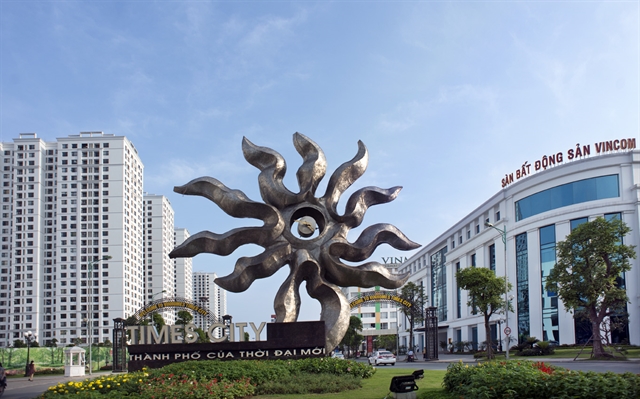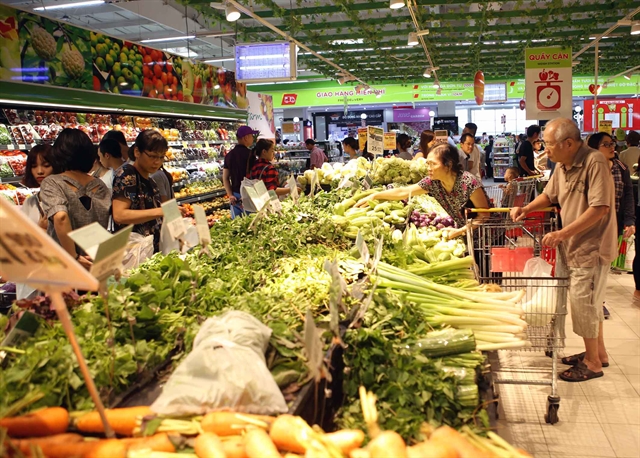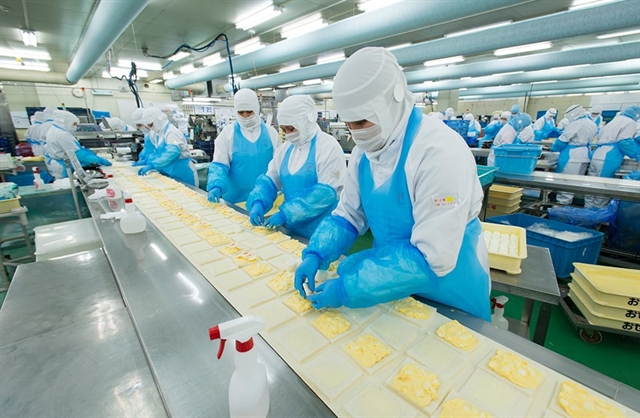 Economy
Economy


|
| People select vegetables in Big C Thăng Long supermarket in Hà Nội. Farmers and farming co-operatives in Hà Nội have reaped success from getting their products onto supermarket shelves. — VNA/VNS Photo Vũ Sinh |
HÀ NỘI — Farmers and farming co-operatives in Hà Nội have reaped success from getting their products onto supermarket shelves, thanks to meeting the retailers’ strict requirements.
Chúc Sơn Fruits and Vegetable Co-operatives in Chúc Sơn Town, Hà Nội’s Chương Mỹ District started applying Vietnamese Good Agricultural Practices (VietGap) on its 15ha of fruit and vegetable in 2017.
The co-operatives’ director Hoàng Văn Khảm said using GAP methods to produce products, especially fresh fruit and vegetables, helped the co-operatives access a modern retail system consisting of supermarkets and canteens at schools or hospitals.
Khảm said that last year, the co-operatives produced 779 tonnes of fruits and vegetable, up 46 per cent compared to the output of 2017, generating revenue of VNĐ 11.2 billion (US$483,000).
He added that nearly 40 per cent of the co-operatives’ products went to hospitals while 43 per cent to major supermarkets like Big C or Vinmart and the remaining products were sold to schools or at traditional markets.
“When linking with modern retailing system, the co-operatives must make detailed production schemes for every cultivation area so they can have enough fruits and vegetable to supply,” Khảm said.
The co-operatives also built net houses and a water-saving system to ensure proper conditions for fruits and vegetable to grow, Khảm said, adding that stable production helped ensure and increase the income of co-operative members.
“When our products are at supermarkets, we gain more confidence from consumers and our branding improves,” Khảm said.
Hoà Bình Co-operatives in Hà Đông District also applied VietGap on its 10ha of vegetables so it could supply schools and stores in the district.
Director of the co-operatives Trịnh Văn Vĩnh said that previously, it had to called on farmers to join the co-operatives but in the last few years, farmers were asking to join so they could learn proper farming technique such as how to make fertiliser or how to use plant protection products properly.
The co-operatives helped its members with input materials and farming skills and further, the co-operatives found buyers for the products, Vĩnh said.
Phùng Văn Hà, director of Núi Bé Co-operatives in Chương Mỹ District, said as soon as the co-operatives applied VietGap to its 15.5 ha grapefruit farm, the fruit could enter supermarkets and food stores in the city.
“Our grapefruit is sweet and tasty, with no chemical residue and we also provide origin-tracing stamps,” Hà said.
Đinh Thị Mỹ Loan, president of Việt Nam Retailers’ Association, said the modern retailing system had more advantages than traditional ones in terms of diversification, reliable quality and traceable origins of products.
However, according to the association’s survey, in the domestic market, more than 85 per cent of Vietnamese farming products are sold at traditional retail channels including wet markets, wholesale markets or street markets, while only 15 per cent is sold at supermarkets and convenience stores.
Loan said that farming products of households and co-operatives struggled to access supermarkets because their origins were not certificated and producers did not much attention to branding.
“Farmers and co-operatives usually have modest production sizes, resulting in unstable supply to supermarkets,” Loan said.
Meanwhile, Loan added that the development of supermarkets and convenience stores in Việt Nam was slow as on average, there was one convenience store for 69,000 people while in Korea, there is one store for about 1,800 people.
According to Hà Nội’s Sub-department of Cultivation and Plant Protection, about 1.5 per cent of vegetables grown in Hà Nội are sold to supermarkets, 1.5 per cent to stores, 1.8 per cent to collective canteens, 12.6 per cent to wholesalers, 26.8 per cent sold at wet markets by growers and about 56 per cent sold at wholesale markets.
Deputy Director of Hà Nội’s Department of Agriculture and Rural Development Tạ Văn Tường said few of Hà Nội’s farming products entered supermarkets and convenience stores as local farmers and co-operatives had yet to connect with distributors while distributors lacked information about the products.
Tường said support policies were needed to develop a better supermarket and convenience store network.
In addition, policies were needed to help farmers and co-operatives develop branding and origin-tracing codes for their products. — VNS









